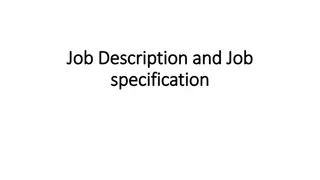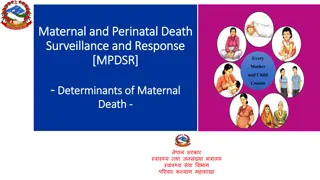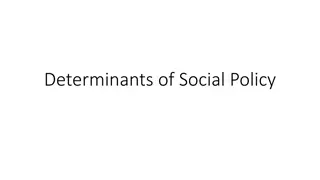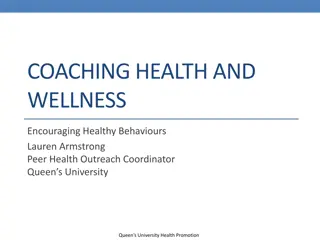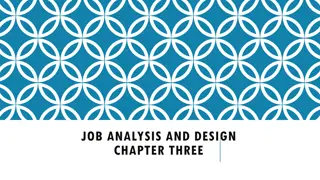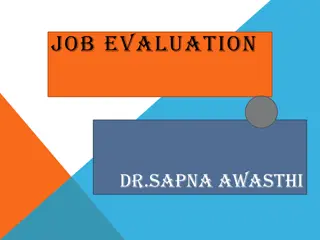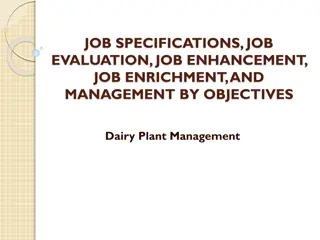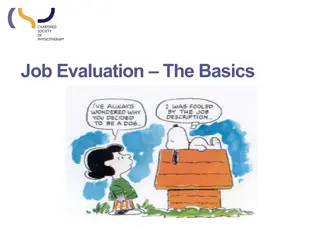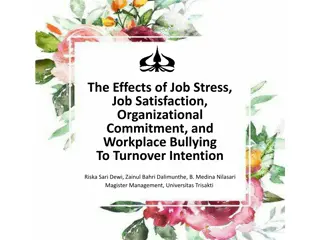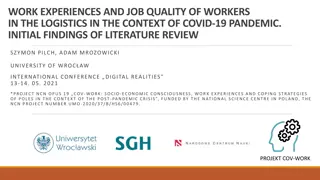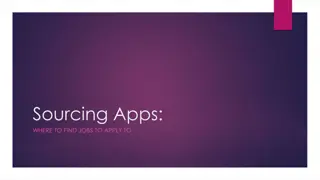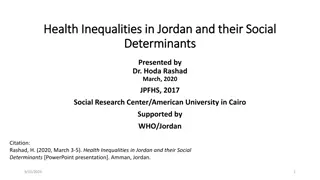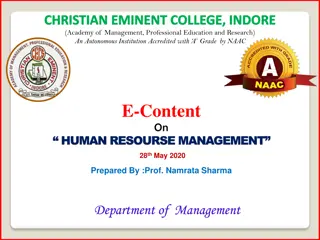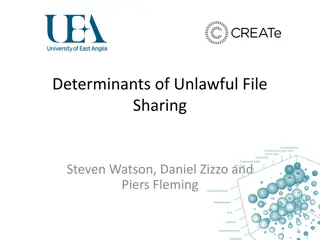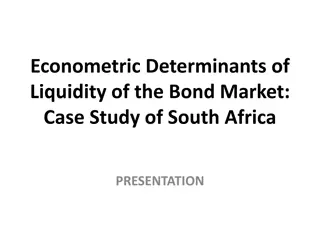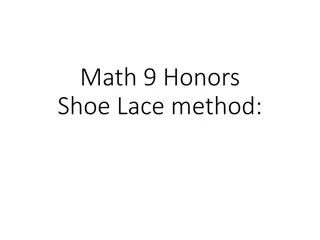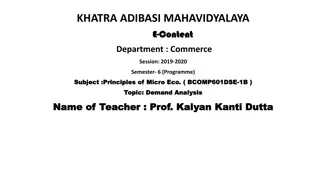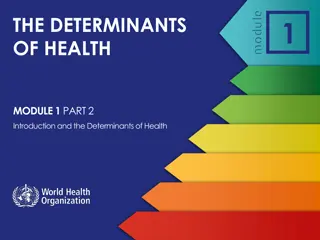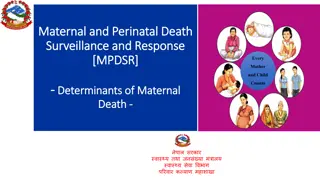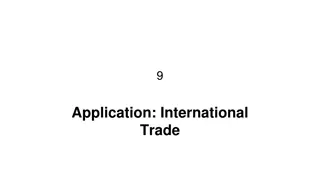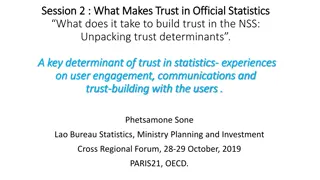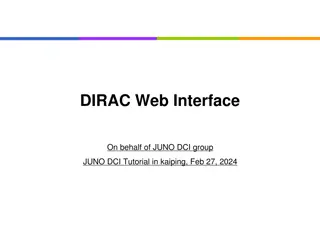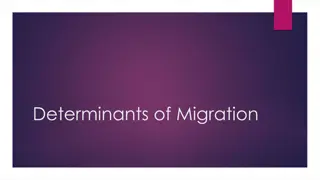Understanding Job Performance and its Determinants
Job performance encompasses what employees do and the results they achieve, often influenced by factors beyond their control. Productivity, evaluative nature, and multidimensional aspects characterize performance evaluation. Performance is determined by declarative knowledge, procedural knowledge, and motivation, highlighting the importance of addressing knowledge gaps and enhancing motivation to improve performance. Additionally, non-task performance, such as organizational citizenship behaviors, plays a significant role in organizational success.
- Job Performance
- Determinants
- Productivity
- Multidimensional Evaluation
- Organizational Citizenship Behavior
Download Presentation

Please find below an Image/Link to download the presentation.
The content on the website is provided AS IS for your information and personal use only. It may not be sold, licensed, or shared on other websites without obtaining consent from the author. Download presentation by click this link. If you encounter any issues during the download, it is possible that the publisher has removed the file from their server.
E N D
Presentation Transcript
DEFINING JOB PERFORMANCE
JOB PERFORMANCE BASICS Job performance relates to what employees do Results (effectiveness) a separate issue: often due to factors beyond employee s control (economy, customers, coworkers, etc.) Productivity: ratio of results (effectiveness) to the cost of achieving that effectiveness Performance is: Evaluative: can be judged in terms of whether they are good or bad for helping individual, unit, and organization meet goals Example: can rate employee on their written communication Multidimensional: many different kinds of behaviors that can be examined Example: teamwork, adaptive behaviors, task behaviors, etc.
DETERMINANTS OF PERFORMANCE Performance determined by 3 things (Campbell et al., 1993): Declarative knowledge: knowledge about facts and things Example: What the laws are related to adverse impact, the advantages of a person-oriented work analysis compared to a work-oriented work analysis Procedural knowledge: knowledge about how to do things Example: how to run an ANOVA in SPSS, how to conduct training for new employees Motivation: choices about: Whether to work on something: Should I work on this report? How hard to work on something: Should I try really hard to fix the results section of this report? How long to work on something: Should I work for one hour or three hours on this report?
DETERMINANTS OF PERFORMANCE Performance = declarative knowledge x procedural knowledge x motivation If any component of this is 0, then performance will also be 0 (i.e., performance will suffer) Example: if you know the theory behind ANOVA and are really motivated to run some ANOVAs for a report at work, but don t know how to run them in SPSS (your organization s only stats software), your performance on the task run analyses for technical reports will be poor
DETERMINANTS OF PERFORMANCE If performance is poor, need to identify why it s poor If employee is lacking knowledge or skills to perform a task, they need additional training If employee is lacking motivation, their motivation needs to be increased (through better goals, better job design, etc.)
NON-TASK PERFORMANCE: OCB Organizational citizenship behavior (OCB): behavior that goes beyond what is expected 3 kinds of OCB (Borman, 2004): Personal support: helping others in the organization Example: teaching a coworker how to run an EFA in SPSS Organizational support: supporting and standing behind the organization: loyalty Example: correcting friend when she says something negative and incorrect about the organization Conscientious initiative: putting in extra effort as needed Example: coming in to work 1 hour early to get a head start on an important presentation
NON-TASK PERFORMANCE: CWB Counterproductive work behaviors (CWB): voluntary behavior that violates organizational norms and threatens organization, its members, or both 2 general categories (Sackett & Devore, 2001): Interpersonal deviance: directed at individuals Example: Spreading gossip about an employee s alleged affair with his supervisor Organizational deviance: directed at the organization Property deviance: harming organizational property Example: stealing computer from office Production deviance: harming production processes Example: doing purposefully sloppy work on report
CAMPBELLS 8-FACTOR MODEL OF JOB PERFORMANCE Antecedents of performance: declarative knowledge, procedural knowledge, and motivation Job-specific task proficiency Non-job-specific task proficiency Written and oral communication Demonstrating effort Maintaining personal discipline Facilitating peer and team performance Supervision/leadership Management/administration
CAMPBELLS MODEL Job-specific task proficiency: doing the tasks the job requires Example: Analyzing data for technical reports Non-job-specific task proficiency: doing things not specific to your job Example: Creating expense report at end of month Written and oral communication: proficiency in writing and speaking Example: Giving coherent presentation about results of validation study to clients Demonstrating effort: consistency of effort, and willingness to expend extra effort if needed Example: Staying late to help plan the pilot test of a new training program you re in charge of
CAMPBELLS MODEL Maintaining personal discipline: avoiding negative behavior and obeying laws and rules Example: Refraining from shouting at an annoying coworker Facilitating peer and team performance: helping to coordinate, support, and direct work group Example: Resolving a conflict between team members about how to analyze ordinal data Supervision/leadership: influencing behavior of subordinates Example: meeting with subordinate about poor work performance and helping them develop a plan for improvement Management/administration: administrative activities Example: hiring new employee to replace one who quit
TYPICAL VS. MAXIMUM PERFORMANCE Maximum performance: the very best that an employee can do Example: working 5 14-hour days to make sure that a project is completed and delivered to the client on time Determined mostly by abilities Typical performance: what an employee usually does Example: working 5 8-hour days to chip away at tasks necessary for a new project (with ample lunchtime, chatting, and Facebooking interspersed throughout) Determined mostly by personality
CRITERION DEFICIENCY AND CONTAMINATION Ultimate criterion: every relevant aspect of job performance that you could ever want to measure Actual criterion: the aspects of job performance that you actually measure We want our actual criterion to be as close to the ultimate criterion as possible
CRITERION DEFICIENCY Criterion deficiency: our measure of job performance is missing something important Example: Neglecting to measure technical report writing for a research analyst Actual criterion Ultimate criterion
CRITERION CONTAMINATION Criterion contamination: measuring something that isn t relevant to the job Example: measuring technical report writing for research analyst when the network crashed, resulting in the loss of the initial report draft Actual criterion Ultimate criterion


